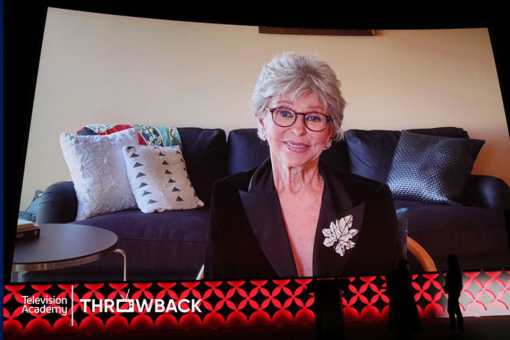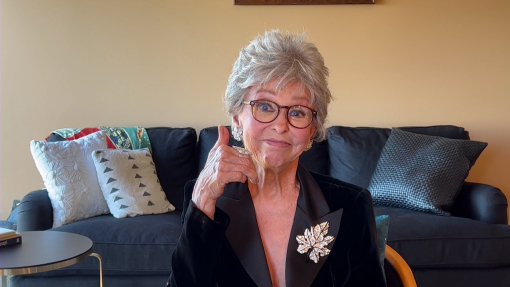“I think my awkwardness on camera is the real reason I am still here today. It has aroused the mother instinct of America.” — Ed Sullivan
He was supposed to have moved “like a sleepwalker.” His smile was once described as “that of a man sucking a lemon.” He was called Mr. Rigor Mortis, the Great Stone Face, the Miltown Maestro, and the Walking Wooden Indian. His personality and his mannerisms made him a prime target for mimicry, and he became one of the most satirized men in America.
“Stony-faced, baggy-eyed … a mangler of thought and language, a stumbling, bungling, fumbling perpetual amateur who has yet to master the smallest gesture, the simplest phrase” — that’s what Newsweek thought of him. But Ed Sullivan, television’s most unlikely star, had the last laugh. He defied all the odds and survived all the barbs to preside over the longest-running variety show in the history of American television.
He and his CBS program, The Ed Sullivan Show, came to television during the medium’s earliest years, continued through its so-called golden years, and outlasted many of the following years to become not only a television fixture, but a national institution.
Sullivan’s longevity on television sometimes puzzled even him. “What have I got?” he once asked a friend as they both were attempting to account for that longevity. The friend replied, “I don’t know, but you’ve got it.”
What Sullivan had was a sharp, nearly infallible instinct for talent, a showmanship that easily rivaled Barnum’s, good taste, and, as he himself said, a newspaperman’s “sensitivity to public trends.” Moreover, as the mimics and the satirists had discovered, he possessed a distinct personality: a naturalness, a spontaneity, even a clumsy trustworthiness that inspired confidence in a nation of viewers who saw those qualities as endearing and endemic to the American character. Yet, more than anything else, he and his show had universal appeal. “Something for Everyone” was his credo, a credo he applied to the new medium that was in the process of discovering its own universality.
“He has invented a whole new form of television,” producer Leland Hayward once said of Sullivan and his phenomenon. “It’s entirely his own, which explains why copyists have failed.”
Born in Manhattan on September 28, 1902 (along with a twin brother, Daniel, who died in infancy), Edward Vincent Sullivan was reared in Port Chester, New York, by Irish parents who wanted a relatively rural life for their five children. At Port Chester High, Sullivan turned himself into a football/baseball/basketball/track hero even as he was learning “to love words and language,” he later recalled. After his graduation from high school, he combined athletics and language to begin his career as a sports writer for the Port Chester Daily Item at $10 a week.
The career soon took him to the Hartford Post and later to the New York Evening Mail, where his first big story was an interview with prizefighter Jack Dempsey in 1923. Of his interview with Dempsey and other sports figures of the time, Sullivan once said, “The door opened to a world more glamorous, fascinating, and exciting than I’d ever imagined, for at the time, the country was just entering what might be called the golden age of sports.”
A succession of short-lived jobs followed at New York’s Morning World, the Bulletin, the Leader, and finally the Graphic, where he began writing the paper’s Broadway gossip column. In 1932, the Graphic folded, and Sullivan moved himself and his column over to the Daily News, where he remained for the next four decades.
Although his Broadway columns were widely read, the young, ambitious Sullivan ventured into show business during this period as a means of supplementing his income and gaining further recognition. His ventures, however, were mostly abortive. Throughout the 1930s, he wrote or managed to get original story credits on four ‘B’ movies, including the little-remembered Big Town Czar, in which he appeared as an actor.
Following the tradition of Broadway columnists of that period, he also served as master of ceremonies of numerous vaudeville revues in New York and elsewhere in touring companies across the country. It was his work as an emcee (a sixteen-year labor he had performed during summers since 1932) that led him to television, where he finally did enter the “glamorous, fascinating, exciting” world he had long sought.
In the late summer of 1947, Sullivan hosted CBS’s first remote telecast, the annual Harvest Moon Ball, from Madison Square Garden. Worthington (Tony) Minor, head of program development at the network, saw the telecast, liked Sullivan’s relaxed and likable manner, and offered the columnist the chance to emcee a major musical variety show that CBS was planning to launch. Sullivan, who had once toyed with the idea of hosting a TV golf program, grabbed the network’s offer.
With such guests as Richard Rodgers and Oscar Hammerstein II, as well as the young comedy team of Dean Martin and Jerry Lewis (who were making their TV debut), the musical variety show premiered as Toast of the Town at 9 on Sunday evening, June 20, 1948. Television critics on most metropolitan newspapers panned it, but the program, which was a hit with the public from the beginning, gradually became a Sunday night viewing habit for millions of households.
Some critics called it “vaudeo,” and indeed Toast of the Town (changed to The Ed Sullivan Show in 1955) was a latter-day vaudeville, an electronic vaudeville complete with comics, dancers, elephants, acrobats, ventriloquists, and dog acts. Popular singers also found a showcase tor their talents on the program. For instance, in the fall of 1956, Sullivan gave Elvis Presley the opportunity to create his greatest impact as a rising rock ‘n’ roller when he appeared on the show. On February 9, 1964, Sullivan also introduced the Beatles to their first American television audience, thereby garnering for his show the largest audience in television history at that time. According to the Nielsen ratings, 73.9 million viewers in the grip of Beatlemania watched the four mop-headed musicians from Liverpool.
“Before the coming of public television, Sullivan was our primary introduction to the high arts,” writes Sullivan biographer Jerry Bowles in A Thousand Sundays. "He brought us the likes of Rudolph Nureyev, Margot Fonteyn, and the great Russian Moiseyev Ballet. Roberta Peters and Maria Callas were there — right after the great dog act from Miami, but indisputably there. … It is said that Sullivan did more to introduce the American heartland to culture than any other personality in the history of television. If that is so, one can thank the catholic nature of his show."
The Ed Sullivan Show carried on for twenty-three years; much of it aired live during an age when live television was on the decline. Many entertainers made their American television debuts on the program, including Lena Horne, Dinah Shore, Eddie Fisher, Bob Hope, and Charles Laughton. But in June 1971, the show was canceled, a victim of declining ratings, changing viewing habits, and the network’s scramble to capture a greater share of the youth market.
After the program went off the air, Sullivan and his son-in-law, producer Bob Precht, developed such specials as The Sullivan Years (1972) and Ed Sullivan’s Broadway (1973), both winners in the ratings stakes.
Sullivan, one of television’s leading impresarios, the man who brought some of the world’s greatest entertainers into the nation’s living rooms, died in 1974.
This tribute originally appeared in the Television Academy Hall of Fame program celebrating Ed Sullivan's induction in 1985.










